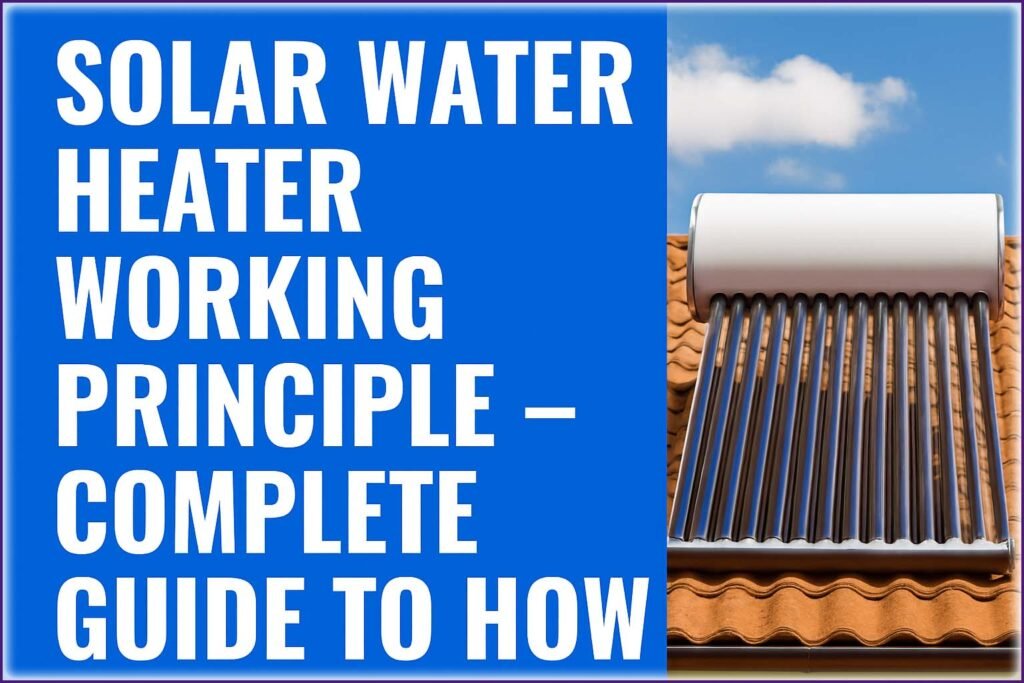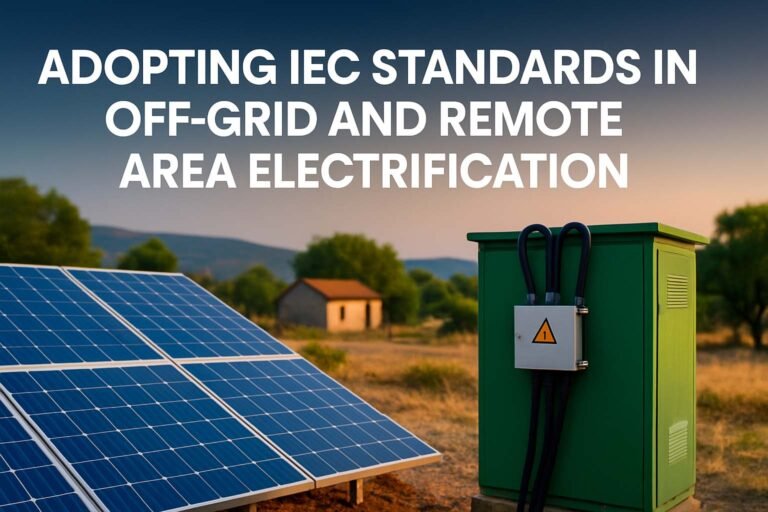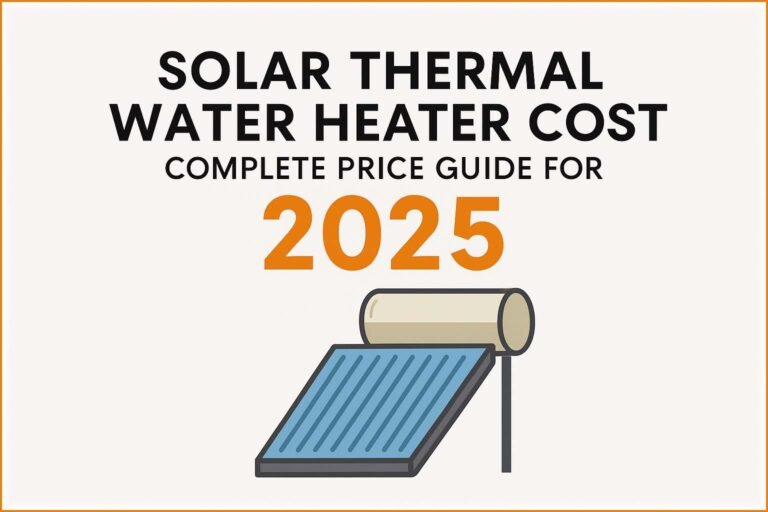Solar Water Heater Working Principle – Complete Guide to How It Works
A solar water heater is one of the smartest and most sustainable ways to get hot water using the energy of the sun. It reduces electricity bills, helps the environment, and provides reliable heating for homes and industries. Understanding the solar water heater working principle can help you make better decisions when choosing or maintaining one.
Unlike conventional water heaters that rely on gas or electricity, a solar water heater uses solar radiation to heat water stored in an insulated tank. It works silently, efficiently, and can last for decades with minimal maintenance.
Table of Contents
Table of Contents

Before we dive deeper, let’s first understand the basic concept behind solar heating. Sunlight contains thermal energy. This energy can be captured by specially designed collectors and transferred to water. The result? Hot water that can be used for bathing, washing, or even industrial processes—all powered by free solar energy.
Key Takeaways
- A solar water heater converts sunlight into heat energy to warm water.
- The system mainly consists of solar collectors, a storage tank, and circulation pipes.
- It reduces electricity bills and carbon footprint while offering long-term reliability.
- Understanding the solar water heater working principle helps in better maintenance and efficiency.
Understanding the Solar Water Heater Working Principle
The solar water heater working principle is based on the simple physics of heat transfer — the sun’s radiation is absorbed and converted into heat energy. This heat is then used to raise the temperature of water inside the system.
A typical solar water heating system has three major components:
- Solar collector (flat plate or evacuated tube type)
- Insulated storage tank
- Piping and control system
Know more about Top Solar Inverters for Home Use: Engineering Comparison & Cost Guide 2025
The collector captures sunlight and converts it into heat. The water either flows through the collector or in pipes connected to it. The heat from the collector warms the water, which is then stored in the insulated tank.
During sunny days, the water temperature can reach 60°C to 80°C easily, depending on system size and weather. The heated water is available for use day and night since the tank prevents heat loss.
Main Components and Their Functions in Solar Water Heater Working Principle
To understand the solar water heater working principle, let’s break down the function of each component:
| Component | Function | Description |
|---|---|---|
| Solar Collector | Absorbs sunlight and converts it into heat | Usually flat plate or evacuated tube; coated with selective material for maximum absorption |
| Storage Tank | Stores the hot water | Well insulated to reduce heat loss; connected to cold water inlet and hot water outlet |
| Pipes & Fittings | Circulate water or heat-transfer fluid | Made of copper or high-temperature plastic; carry water between tank and collector |
| Insulation | Prevents heat loss | Used on tank and pipes to maintain water temperature |
| Controller & Pump (in active systems) | Controls water flow based on temperature difference | Ensures efficient heat transfer between collector and tank |
Each of these parts plays a key role in ensuring efficient solar heating. Without proper insulation or collector efficiency, performance can drop significantly.
Types of Solar Water Heaters Based on Working Principle
The solar water heater working principle varies slightly depending on the system design. There are two main types: active (forced circulation) and passive (natural circulation) systems.
1. Active Solar Water Heating System
Active systems use electric pumps and controllers to circulate water between the collector and the storage tank.
Working Principle of Active Solar Water Heating System:
Sensors detect the temperature difference between the collector and tank. When the collector is hotter, the pump starts circulating water or a heat-transfer fluid through the collector. The fluid absorbs heat and moves it to the storage tank through a heat exchanger.
Best For:
Areas with freezing conditions or where better control and efficiency are needed.
Know more about Level 2 EV Charger Installation Cost: Homeowner’s Guide in 2025
2. Passive Solar Water Heating System
Passive systems rely on natural convection (thermosiphon effect) to move water. No pumps or electronic controllers are used.
Working Principle:
Cold water from the bottom of the storage tank moves into the collector as it gets heated by the sun. The hot water rises and flows back into the tank, creating continuous circulation.
Best For:
Warm or tropical climates where freezing is not an issue. These systems are simpler, more reliable, and cost-effective.
Flat Plate vs Evacuated Tube Collectors – Which is Better?
Another important aspect of the solar water heater working principle lies in the type of collector used.
| Feature | Flat Plate Collector (FPC) | Evacuated Tube Collector (ETC) |
|---|---|---|
| Design | Flat metal sheet with copper tubes | Glass tubes with vacuum insulation |
| Efficiency | Moderate | Higher due to reduced heat loss |
| Cost | Lower | Slightly higher |
| Durability | Stronger, suitable for rough weather | Fragile glass tubes need care |
| Performance in Winter | Less effective | Excellent heat retention |
For domestic use in moderate climates, FPC systems are common. However, in colder or cloudy regions, ETC systems deliver better results due to their superior insulation.
Step-by-Step Solar Water Heater Working Principle
Let’s walk through the solar water heater working principle step by step:
- Sunlight Hits the Collector
Solar radiation strikes the absorber surface of the collector. The absorber material (usually black-coated metal) converts solar energy into heat. - Heat Transfer to Water or Fluid
The heat is conducted to the pipes carrying water or a special antifreeze liquid. As the fluid passes through the collector, its temperature increases. - Circulation Process
Depending on the system type, the heated fluid either moves naturally or via pump to the storage tank. - Heat Exchange and Storage
In systems using heat-transfer fluids, the fluid releases its heat to the water in the tank through a heat exchanger. The hot water remains stored in the insulated tank for later use. - Continuous Supply of Hot Water
Whenever you use hot water, cold water enters the system, and the process repeats—maintaining a consistent supply.
Use our online tool Wire Size Calculator for Solar Panels – Avoid Power Loss in Off-Grid and Hybrid Systems
Efficiency Factors Affecting the Solar Water Heater Working Principle
Several factors determine how efficiently a solar water heater performs:
- Solar Radiation Intensity: More sunlight means faster heating.
- Collector Orientation: South-facing collectors (in the Northern Hemisphere) capture the most sunlight.
- Tilt Angle: A tilt equal to the local latitude ensures maximum solar gain.
- Water Quality: Hard water can cause scaling and reduce heat transfer efficiency.
- Insulation Quality: Better insulation prevents heat loss and improves performance.
Even small improvements, like cleaning the collector surface regularly or insulating exposed pipes, can enhance the efficiency of the system significantly.
Advantages of Understanding Solar Water Heater Working Principle
Knowing how the solar water heater working principle operates helps homeowners and businesses use the system effectively.
- Energy Savings: Reduces dependence on electricity or gas.
- Eco-Friendly: No greenhouse gas emissions.
- Low Maintenance: Fewer moving parts, longer lifespan.
- Cost Efficiency: Once installed, it offers nearly free hot water for years.
- Energy Independence: Ideal for off-grid or remote areas.
Know more about Floating Solar Panel Systems Design & Cost Analysis
Applications of Solar Water Heaters
The solar water heater working principle is used in a variety of sectors:
- Residential buildings for bathing, washing, and cooking.
- Hotels and hospitals for large-scale hot water requirements.
- Industries for process heating and cleaning operations.
- Swimming pools for maintaining water temperature.
Common Problems and Solutions
| Problem | Possible Cause | Solution |
|---|---|---|
| Water not heating properly | Cloudy weather or collector shading | Clean the collector, check orientation |
| Low water pressure | Air block or leakage | Bleed air from the system and check for leaks |
| Scaling in pipes | Hard water | Use descaling agents or install water softener |
| Heat loss overnight | Poor insulation | Insulate tank and exposed pipes properly |
Routine inspection ensures consistent system performance and longevity.
Future of Solar Water Heating Systems
With technological progress, the solar water heater working principle is being optimized using better materials, smart sensors, and hybrid systems. Newer models can integrate with photovoltaic panels or heat pumps for all-weather heating.
These innovations make solar water heaters an essential part of modern sustainable homes and green buildings.
Know more about Off-Grid Solar System Design Guide for Remote Areas
Conclusion
The solar water heater working principle is a perfect blend of simplicity and science. It captures free solar energy and turns it into usable hot water without pollution or recurring costs.
Understanding how it works empowers you to choose the right type, maintain it efficiently, and enjoy maximum savings. Whether for your home, business, or industry, solar water heaters are a smart investment in both the environment and your energy future.
Follow Us on Social:
Subscribe our Newsletter on Electrical Insights for latest updates from Electrical Engineering Hub
#SolarWaterHeater, #SolarEnergy, #RenewableEnergy, #GreenTechnology, #SustainableLiving, #SolarHeating, #SolarPowerSystem, #EcoFriendlyHome, #WaterHeater, #SolarHotWater, #EnergySaving, #SolarSystem, #SolarPanel, #CleanEnergy, #HomeImprovement





